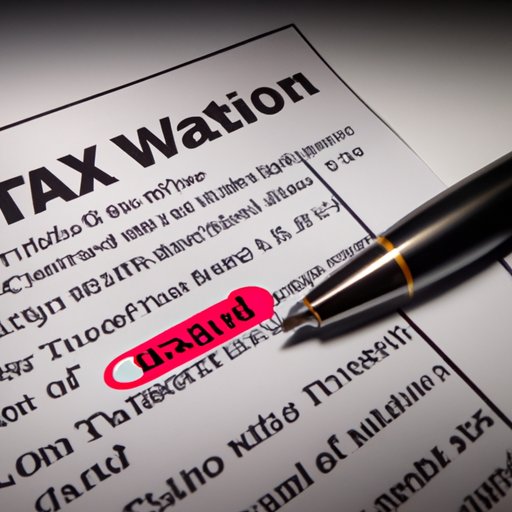Introduction
Tax write-offs are a great way to reduce your taxable income and save money. But understanding how they work can be confusing. In this article, we’ll discuss the basics of tax write-offs, how to maximize them, and common misconceptions about them.
Understanding the Basics of Tax Write-Offs
A tax write-off is a reduction in taxable income that is allowed by the IRS. It reduces the amount of taxes you owe, resulting in a lower tax bill. There are two types of tax write-offs: deductions and credits.
Types of Tax Deductions
Deductions are expenses that can be subtracted from your taxable income. Common deductions include charitable donations, business expenses, medical expenses, and mortgage interest. You must itemize your deductions in order to take advantage of them.
Eligibility Requirements
In order to qualify for a deduction, you must meet certain criteria. For example, if you’re claiming a business expense deduction, you must be able to prove that the expense was necessary and related to your business. If you’re claiming a medical expense deduction, the expense must exceed 7.5% of your adjusted gross income.
How to Claim a Tax Deduction
If you think you may be eligible for a tax deduction, you should consult with a tax professional who can help you determine if you qualify. Once you’ve determined that you’re eligible, you must file Form 1040 and itemize your deductions. You’ll also need to provide documentation of the expenses you intend to deduct.
How to Maximize Your Tax Write-Offs
When it comes to maximizing your tax write-offs, there are several steps you can take. Here are some tips to keep in mind:
Keeping Records of Expenses
It’s important to keep detailed records of all your expenses throughout the year. This will make it easier to track deductible expenses, and it will also make it easier to prove that the expenses were necessary and related to your business or other activities.
Taking Advantage of Tax Credits
Tax credits are another way to reduce your tax burden. Tax credits are different from deductions in that they’re applied directly to your tax bill rather than reducing your taxable income. Common tax credits include the Earned Income Tax Credit (EITC), the Child Tax Credit, and the Saver’s Credit.
Understanding Maximum Allowed Deductions
It’s important to understand the maximum amount of deductions you’re allowed to take each year. The IRS has set limits on certain deductions, such as the amount of home mortgage interest you can deduct. Knowing these limits can help you plan ahead and maximize your deductions.
The Pros and Cons of Taking Tax Write-Offs
Like any financial decision, there are pros and cons to taking tax write-offs. Here’s a look at some of the benefits and potential downsides.
Benefits of Tax Deductions
The main benefit of taking tax deductions is the potential to reduce your taxable income and save money. Depending on the deductions you take, you could save hundreds or even thousands of dollars on your taxes each year.
Potential Downsides of Tax Write-Offs
One potential downside of taking tax deductions is the extra paperwork involved. In order to claim deductions, you must provide proof of expenses and complete additional forms. This can be time-consuming and can cause confusion when filing taxes. Additionally, some deductions have limits or eligibility requirements, so they may not be available to everyone.
Common Misconceptions about Tax Write-Offs
There are several common misconceptions about tax write-offs. Here are some of the most common:
Not Necessarily Limited to Business Expenses
Many people believe that tax write-offs are only available to business owners, but this isn’t true. There are many deductions available to individuals, such as charitable donations, medical expenses, and home mortgage interest.
Not Subject to Taxable Income Limits
Another misconception is that deductions are subject to taxable income limits. This is false; in most cases, deductions are not subject to these limits. However, some deductions do have income limits, so it’s important to check the rules before claiming any deductions.
No Need to Itemize to Take Advantage of Tax Deductions
Finally, some people mistakenly believe that they don’t need to itemize their deductions in order to take advantage of them. This isn’t true; in order to claim deductions, you must itemize your deductions on Form 1040.
Conclusion
Tax write-offs can be a great way to reduce your taxable income and save money. Understanding the basics of tax deductions and credits, how to maximize them, and common misconceptions about them can help you get the most out of your deductions. With careful planning and record keeping, you can save money on your taxes each year.
(Note: Is this article not meeting your expectations? Do you have knowledge or insights to share? Unlock new opportunities and expand your reach by joining our authors team. Click Registration to join us and share your expertise with our readers.)
